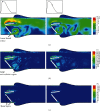Simulation of Mechanical Heart Valve Dysfunction and the Non-Newtonian Blood Model Approach
- PMID: 35498142
- PMCID: PMC9042627
- DOI: 10.1155/2022/9612296
Simulation of Mechanical Heart Valve Dysfunction and the Non-Newtonian Blood Model Approach
Retraction in
-
Retracted: Simulation of Mechanical Heart Valve Dysfunction and the Non-Newtonian Blood Model Approach.Appl Bionics Biomech. 2023 Nov 29;2023:9896350. doi: 10.1155/2023/9896350. eCollection 2023. Appl Bionics Biomech. 2023. PMID: 38075140 Free PMC article.
Abstract
The mechanical heart valve (MHV) is commonly used for the treatment of cardiovascular diseases. Nonphysiological hemodynamic in the MHV may cause hemolysis, platelet activation, and an increased risk of thromboembolism. Thromboembolism may cause severe complications and valve dysfunction. This paper thoroughly reviewed the simulation of physical quantities (velocity distribution, vortex formation, and shear stress) in healthy and dysfunctional MHV and reviewed the non-Newtonian blood flow characteristics in MHV. In the MHV numerical study, the dysfunction will affect the simulation results, increase the pressure gradient and shear stress, and change the blood flow patterns, increasing the risks of hemolysis and platelet activation. The blood flow passes downstream and has obvious recirculation and stagnation region with the increased dysfunction severity. Due to the complex structure of the MHV, the non-Newtonian shear-thinning viscosity blood characteristics become apparent in MHV simulations. The comparative study between Newtonian and non-Newtonian always shows the difference. The shear-thinning blood viscosity model is the basics to build the blood, also the blood exhibiting viscoelastic properties. More details are needed to establish a complete and more realistic simulation.
Copyright © 2022 Aolin Chen et al.
Conflict of interest statement
The authors declared that they have no conflicts of interest regarding this work.
Figures




Similar articles
-
Hemodynamic Effects of Subaortic Stenosis on Blood Flow Characteristics of a Mechanical Heart Valve Based on OpenFOAM Simulation.Bioengineering (Basel). 2023 Mar 1;10(3):312. doi: 10.3390/bioengineering10030312. Bioengineering (Basel). 2023. PMID: 36978704 Free PMC article.
-
Numerical investigation of different viscosity models on pulsatile blood flow of thoracic aortic aneurysm (TAA) in a patient-specific model.Comput Methods Biomech Biomed Engin. 2023 Jun;26(8):986-998. doi: 10.1080/10255842.2022.2102423. Epub 2022 Jul 26. Comput Methods Biomech Biomed Engin. 2023. PMID: 35882063
-
Influence of non-Newtonian behavior of blood on flow in an elastic artery model.J Biomech Eng. 1996 Feb;118(1):111-9. doi: 10.1115/1.2795936. J Biomech Eng. 1996. PMID: 8833082
-
Ramifications of Vorticity on Aggregation and Activation of Platelets in Bi-Leaflet Mechanical Heart Valve: Fluid-Structure-Interaction Study.J Biomech Eng. 2022 Aug 1;144(8):081002. doi: 10.1115/1.4053665. J Biomech Eng. 2022. PMID: 35079764
-
Flow-induced platelet activation in bileaflet and monoleaflet mechanical heart valves.Ann Biomed Eng. 2004 Aug;32(8):1058-66. doi: 10.1114/b:abme.0000036642.21895.3f. Ann Biomed Eng. 2004. PMID: 15446502
Cited by
-
Perfect prosthetic heart valve: generative design with machine learning, modeling, and optimization.Front Bioeng Biotechnol. 2023 Sep 15;11:1238130. doi: 10.3389/fbioe.2023.1238130. eCollection 2023. Front Bioeng Biotechnol. 2023. PMID: 37781537 Free PMC article.
-
Retracted: Simulation of Mechanical Heart Valve Dysfunction and the Non-Newtonian Blood Model Approach.Appl Bionics Biomech. 2023 Nov 29;2023:9896350. doi: 10.1155/2023/9896350. eCollection 2023. Appl Bionics Biomech. 2023. PMID: 38075140 Free PMC article.
References
-
- Zhengwan Z. H. A. N. G., Chunjiong Z. H. A. N. G., Hongbing L. I., Tao X. I. E. Multipath transmission selection algorithm based on immune connectivity model. Journal of Computer Applications . 2020;40(12):p. 3571.
Publication types
LinkOut - more resources
Full Text Sources

